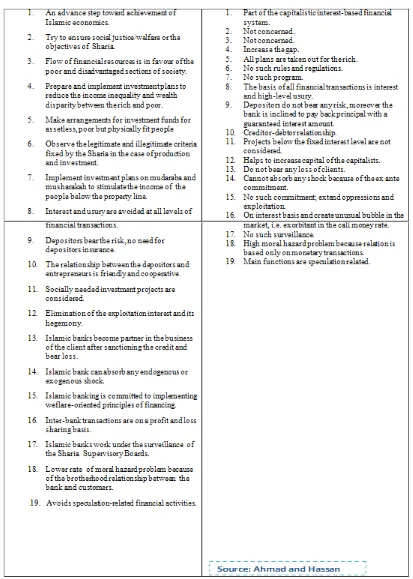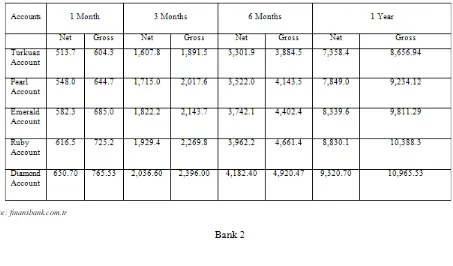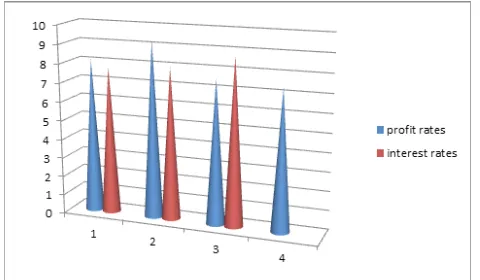Banking and Conventional Banking
Ahmet SEKRETER*Rasit Nurullah SOYHAN** Ali GUVERCIN***
Abidin PISGIN****
Serhat TEKELIOGLU*****
Abstract
The most general argument about Islamic finance is that there is no difference at all between Islamic finance and conventional finance in practice since there exists parallelism between interest rate and profit rate. Some people claim that Islamic finance merely involves change in name. These people state the doubtful situation which is parallelism between interest rate that offering by conventional banks and profit rate that distributed by Islamic financial institutions to prove their arguments against Islamic finance. Aim of this article is to investigate arguments about the mentioned issue above and try to clarify doubts about Islamic finance.
Keywords: Conventional finance, Interest rate, Islamic Banking, Islamic finance, Profit rate JEL: G20, G29, P10, P40
Introduction
Since the late 1990s Islamic financial industry has been growing at a rate of between 10% and 15% per year, and is expected to keep on growing at this rate for some years. The number of financial institutions is increasing in all over the world. Like every other aspect of Muslim life, Is -lamic financial institutions should be governed by Sharia and Fiqh which is interpretation of Sharia if we want to call those institutions as Islamic. Sharia that is Islamic law covers all aspect of life. Sharia has some sources. We can make these sources as two groups and show as follows:
Table 1: Sources of Sharia
Source: Agil Natt, Basic Principles of Islamic Finance, January 2007.
* Lecturer at the Faculty of Business Management, International Black Sea University, Tbilisi, Georgia. E-mail: asekreter@ibsu.edu.ge ** Head Doctor at Karabuk State Hospital, Karabuk, Turkey. E-mail: seyfii@hotmail.com
*** Coordinator of Administrative and Financial Affairs (Regional Director of Hospitals), Ankara, Turkey. E-mail: aliguvercin61@hotmail.com **** Hospital Manager at the Fatih University Hospital, Ankara, Turkey. E-mail: apisgin@yahoo.com
The primary sources of Sharia are the Holy Quran and Sunnah of the holy Prophet. The Quran is the primary legal source of Islam since it is speech of Allah. According to
Is-lamic belief it is necessary obeying injunctions in Holy Quran
by all Muslims. Holy Quran has supplemented by Sunnah. The Sunnah which contains saying of holy Prophet Muham-mad (s.a.s) and the actions done by the holy Prophet or the
actions approved by holy Prophet. Sunnah can be considered as detailed explanations of Holy Quran and clarification of a
matter that is not mentioned in Holy Quran directly. In Quran
Allah says “Indeed you have in the Messenger of Allah an
excellent example for the one who hopes in Allah and looks
to the Last Day” (33: 21). Allah also says in another verse of
Holy Quran “So if you obey him (i.e. Muhammad, s.a.s), only
then you will be guided” (24: 54). Like obeying injunctions in
Holy Quran, obeying the orders of the holy Prophet is
neces-sary. Almost all Muslims believe accepting of the orders of Sunnah. The other primary sources of Sharia are Ijma (prin
-ciples of Islamic jurisprudence) and Qiyas (analogical deduc
-tion) which are based on Ijtihad. Ijtihad is the mental effort of scholars having juristic expertise to find solutions for emerg -ing problems and issues.
The latest financial crisis shows that conventional finance system is not perfect. After the crisis Islamic finance became very popular since it is declared as an alternative of conventional finance by both some Muslim and non Muslim
economists. The Muslim population in both Muslim and non
Muslim countries start to prefer Islamic financial institutions rather than conventional ones. In industry there is a simple rule if there is a demand then there is a supply. Islamic finance is being practiced in over 75 countries around the world with about 550 Islamic financial institutions in the field (Muham -mad Ayub, Understanding Islamic Finance, 2007). Islamic as-sets under management stand at around $700 billion and are
growing faster than conventional finance assets. (Islamic Fi
-nancial Services Board).
The basic principles of Islamic finance can be sum -marized as follows:
Prohibition of Interest: Under Islamic law, any level of interest is prohibited. Islam encourages the making profit but
forbids the charging of interest. Quran says that “But Allah has permitted and forbidden usury…” (2:275)
Ozsoy (2010) defines the interest as follow:
Interest is of two kinds. First, interest of loan (riba al-dain in Arabic), one that appears in loans as a percentage or any fixed payment added to the principle, is the most wide -spread, and the most debated, kind of interest known by all. Lending money, say €100, at a certain interestrate, say 5%, is the example. Second is interest of exchange (riba al-bai’ in Arabic), one that appears in exchanges.
The second one -interest of exchange- is also divided into two kinds; one is called interest of surplus (riba alfadl in Arabic) that appears as a quantitative surplus in one of the exchanged goods of the same kind -as in the case when two
that appears in exchanges as a quantitative or potential sur -plus (value differentiation) when the delivery of one of the goods exchanged is delayed, as in the case when a ton of iron is sold for the same amount of iron on a deferral basis; let alone for a larger amount of delayed iron.
Prohibition of Uncertainty: The terms and the conditions which of the risk are not clearly understood by all parties to a
financial transaction are not allowed.
Profit-Loss Sharing: Sharing profit or returns from as
-sets are permitted if parties involved in a financial transaction
share both the risks. So the business risks must be shared by the lender (seller) and borrower (buyer).
Ethical Investments: Investments such as alcohol, por -nography, gambling, and pork based products are not allowed.
Money: Money is very important issue in any of financial
system. The status, role, and function of money are not same
in conventional finance and in Islamic finance. The philoso -phy of Islam about money is completely different from the
conventional system. The usage of money is limited with its basic purpose in Islamic finance. Money has to be used as a medium of exchange and a measure of value. Money itself
cannot be used for the purpose of trade. Money has to be ex-changed for money, it can be borrowed but the payment on
both sides must be equal. In conventional system, money is a
commodity that can be sold or bought. Money can be rented
Islamic finance is a relatively young industry but with a great potential. The market size is estimated to be worth about £250 billion globally (GMB publishing, Islamic Fi-nance, 2008). Islamic finance has a short history on the other hand from a small base it reaches a very huge size in the market when its short history is concerned.
Islamic finance is the most developed branch of eco -nomics. It has been developing exponentially. There are many new concepts and tools introduced as an Islamic finance products in recent years. However Muslim com -munity is not sure that what are admissible and what are forbidden. In the Medivial time the church declared deci -sions about the discussed topics, like Vatikan in these days. When we look at the all Muslims all around the world, we see that there is no final authority which involve the discussions and gives final decisions especially in Sunni Muslims. There are some independent advisory institu -tions but they represent some parts of the community. In this case how a muslim will decide that an Islamic prod-uct is really Islamic or not. We have primary and second -ary sources, there are Fatwas about every aspects of daily life. Islam is designed to supply everthing what is needed and to bring solutions of human beings. So if we search we can find our answer. The issue is the problem or the situation is not clearly stated. To decide an Islamic tool or product complies with Shariah or not it must defined very well and the process of the activities must be clear in every steps. Transparency will help to eliminate the differences between theory of Islamic finance and practice of Islamic finance. Islamic financial products refer to financial market transactions, any operations and services that comply with Sharia that is Islamic laws, rules and principles.
Data and Methodology: Parallelism between Interest Rate and Profit Rate
Data was collected through the official web pages of some Turkish banks that run as conventional banks and some Islamic financial banks where running in Turkey. The of -fered interest rate by banks represented and evaluated their average. Same process was done for profit rates that dis -tributed by some Islamic banks in Turkey. These data were announced the public through the official web pages of the chosen financial institutions in the study. In the second phase there would be a simple comparison of those inter-est rates and profit rates. By using tables the existence of parallelism would be tried to state to investigate the pos -sible reasons. The comparison of inflation rate and profit rate that distributed by Islamic banks that run in Turkey was stated in the study too. Parallelism among the interest rates that offered by conventional banks, profit rates that
ket will be analyzed and discussed by the author. After es-tablishing the real situation, the reasons behind the facts will be investigated and stated.
Table 3: Distributed profit rates by selected Islamic banks in Turkey
Source: finansbank.com.tr
Source: albarakaturk.com.tr 07/12/2010
Source:kuveytturk.com.tr
It can be seen that rates of return are very close in these Islamic banks. The interval of rates of gross return is between 9.35% and 9.55%. The net return rate is about %8. The inflation rate in Turkey is 9.25% (source: TUIK, September 2010). Now let examine interest rates of con-ventional banks in Turkey.
Table 4:Profit rates summary of Islamic banks in Turkey
However if time is chosen as one year, net profit in -stead of gross, and average of different types of accounts that are offered by the given Islamic banks above after that average profit rate is calculated as %8.13.
In the research of Sekreter (2011) randomly three conventional banks are chosen, and the interest rates
that offered by banks differ according to amount that is in-vested to the bank and the chosen maturity. The following table shows these different options for interest rates and the interest rates per annum are summarized in the next table as follow:
Table 6: Average interest rates per annum offered by conventional banks in Turkey
When the average interest rate is calculated, the result is %8.17.
The result we observe that Islamic banks’ return rates and conventional banks’ interest rates are parallel. How it can be possible that there would be many Islamic banks, they will use many types of Islamic financial prod -ucts, they will invest many different areas, they will work according to profit-loss sharing system and then they will distribute almost same amount profit-they never declare any loss to their clients/depositors- that very close to inter -est rates. In the current conditions of contemporary Islamic finance, the explanations about the parallelism between profit rates and interest rates are not convincing people about Islamic finance.
Table 7:Comparison of interest rates and profit rates
The people who have doubts about Islamic finance could not be persuaded because of similarity between re-turn rates and interest rates. Their opinion about Islamic fi -nance is just another name for interest-based system. Some Islamic scholars and jurists say that since Islamic banks are living in an interest-based financial system it is normal that the similarity between interest rates and return rates, otherwise Islamic finance do not have chance to survive in these economical system. They also say that this similarity does not mean that Islamic banks are distributing interest
Conclusion
References
Ayub, M. (2007). Understanding Islamic Finance. Natt, A. (2010). Basic Principles of Islamic Finance. Ozsoy, I. (2010). Islamic Banking: Conceptual
Fundamen-tals and Basic Features.
Sekreter, A. (2011). Importance of Transparency in Islamic Finance.
Sekreter, A. (2011). Sharing of Risks in Islamic Finance. The Holy Qur’an
Internet Sources




